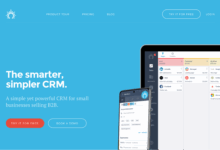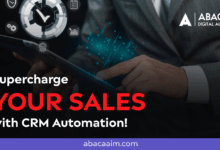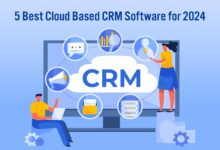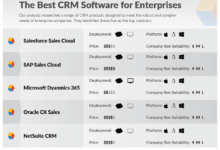CRM Software for Small Business Success
CRM Software for Small Business: Streamlining operations and boosting growth are key for any small business, and the right Customer Relationship Management (CRM) software can be the catalyst. This guide explores how CRM solutions can empower small businesses to manage customer interactions, improve sales, and ultimately, achieve greater success. We’ll delve into choosing the right system, implementing it effectively, and maximizing its potential to enhance your bottom line.
From identifying your specific needs to selecting the perfect platform and training your team, we’ll provide a comprehensive overview, equipping you with the knowledge to make informed decisions and leverage the power of CRM. This isn’t just about software; it’s about building stronger customer relationships and driving sustainable business growth.
Defining Needs for Small Business CRM
Choosing the right CRM (Customer Relationship Management) system is crucial for small businesses aiming to streamline operations and boost growth. A well-implemented CRM can significantly improve customer interactions, sales processes, and overall efficiency, ultimately leading to increased profitability. Understanding the specific needs of your business is the first step in selecting the appropriate software.
Core functionalities a small business CRM must possess typically include contact management (with the ability to store customer details, communication history, and interactions), lead management (tracking potential customers from initial contact to conversion), sales pipeline management (visualizing the sales process and identifying bottlenecks), reporting and analytics (providing insights into sales performance and customer behavior), and basic task and appointment scheduling. Integration with other business tools, such as email marketing platforms and accounting software, is also highly desirable.
CRM Needs Vary Across Small Business Types
The specific CRM functionalities required vary considerably depending on the nature of the small business. A retail business, for instance, will prioritize inventory management integration, point-of-sale (POS) system integration, and customer loyalty program management. Conversely, a service-based business, such as a plumbing company, will focus on scheduling appointments, managing service technicians, and tracking customer service requests. Consulting firms, on the other hand, may place a greater emphasis on project management features, client communication tools, and time tracking capabilities. These differences highlight the importance of selecting a CRM system tailored to the specific operational needs of the business.
Comparison of Free vs. Paid CRM Software
The choice between free and paid CRM software often hinges on the scale and complexity of a small business’s operations. Free options generally offer limited functionality and storage, often lacking advanced features like robust reporting, automation tools, and customizability. Paid options, while carrying a subscription cost, provide greater flexibility, scalability, and a broader range of features to support business growth.
| Feature | Free CRM | Paid CRM |
|---|---|---|
| Contact Management | Basic contact storage; limited fields | Advanced contact management; custom fields, segmentation |
| Lead Management | Basic lead tracking; limited automation | Advanced lead scoring, automation, and routing |
| Sales Pipeline Management | Simple pipeline visualization | Detailed pipeline management; forecasting tools |
| Reporting & Analytics | Limited reporting capabilities | Comprehensive reporting and dashboards; custom reports |
Top CRM Software Features for Small Businesses
Choosing the right CRM can significantly impact a small business’s growth and efficiency. The key lies in selecting a system with features tailored to specific needs, focusing on areas like contact management, sales pipeline optimization, and insightful reporting. This section highlights essential CRM features that deliver real value for small businesses.
Contact Management Features
Effective contact management is the cornerstone of any successful CRM. A well-designed CRM system centralizes all customer interactions, providing a single source of truth for all communication history, purchase records, and interaction details. This eliminates the chaos of scattered spreadsheets and email chains, improving team collaboration and reducing the risk of missed opportunities. Benefits include improved customer service through personalized interactions based on past interactions, simplified lead qualification by tracking engagement levels, and enhanced sales follow-up with automated reminders and task assignments. For example, a small bakery using a CRM could track customer preferences (e.g., allergies, favorite pastries) and automatically send birthday greetings, leading to increased loyalty and repeat business.
Sales Pipeline Management
Sales pipeline management within a CRM streamlines the sales process, offering a clear view of each deal’s progress. This visual representation allows sales teams to identify bottlenecks, prioritize high-potential leads, and forecast revenue more accurately. Features like automated workflows, opportunity tracking, and progress visualization (e.g., Kanban boards) provide a systematic approach to sales management, improving team efficiency and ultimately boosting sales conversion rates. Imagine a small software company using a CRM to visualize their sales pipeline: they can easily see which deals are stuck in the negotiation phase and proactively address any roadblocks, ensuring deals close faster.
Reporting and Analytics Dashboards
Data-driven decision-making is crucial for small businesses. CRM software provides insightful reporting and analytics dashboards, visualizing key performance indicators (KPIs) like sales conversion rates, customer acquisition costs, and customer lifetime value. These dashboards offer a quick overview of business performance, highlighting areas for improvement and enabling data-backed strategies. For instance, a dashboard might show a significant drop in conversion rates from a specific marketing campaign, prompting a review of the campaign’s effectiveness and adjustments to future strategies. Customizable dashboards allow businesses to track metrics most relevant to their specific goals.
CRM Integration with Other Business Tools
Integrating a CRM with other business tools significantly enhances efficiency and data flow.
- Email Integration: Seamlessly manage email communications within the CRM, tracking interactions and automatically logging emails related to specific contacts or deals. This eliminates the need to switch between applications and improves response times.
- Accounting Software Integration: Automate data entry by syncing CRM data (e.g., invoices, payments) with accounting software, reducing manual work and minimizing errors. This provides a unified view of financial and customer data.
- Marketing Automation Integration: Enhance marketing campaigns by integrating CRM data with marketing automation tools. This allows for targeted messaging and personalized campaigns based on customer segmentation and behavior.
- Social Media Integration: Monitor social media mentions and interactions, allowing for proactive customer service and targeted marketing efforts. This enables a holistic view of customer engagement across all channels.
Cost and Implementation of CRM Software
Investing in a CRM system requires careful consideration of both upfront and ongoing costs. Understanding the various pricing models and implementation factors is crucial for small businesses to make informed decisions and avoid unexpected expenses. This section will break down the cost and implementation aspects of CRM software for small businesses, providing a clearer picture of what to expect.
CRM Software Pricing Models
Small businesses typically encounter two main pricing models for CRM software: subscription-based and one-time purchase. Subscription models usually involve recurring monthly or annual fees, often tiered based on features and the number of users. These fees often include software updates, technical support, and access to online resources. One-time purchase models, on the other hand, involve a single upfront payment for the software license. However, this often excludes ongoing support and updates, which may need to be purchased separately. The best model depends on the business’s budget, needs, and long-term growth plans. For example, a rapidly growing business might find a subscription model more flexible, while a smaller, stable business might prefer the predictability of a one-time purchase.
Factors Influencing Total Cost of Ownership (TCO)
The total cost of ownership (TCO) extends beyond the initial software cost. Several factors contribute to the overall expense. These include implementation costs (consultant fees, data migration, training), ongoing maintenance fees (updates, support), and the cost of integrating the CRM with other business systems. Hidden costs, such as employee time spent on data entry and system training, should also be considered. For instance, a complex implementation requiring extensive customization might significantly increase the TCO compared to a simpler, out-of-the-box solution. Accurate budgeting requires a comprehensive assessment of all potential costs.
Implementation Timelines and Complexities
The implementation timeline and complexity vary greatly depending on the chosen CRM platform, the size of the business, and the complexity of data migration. Cloud-based CRMs generally offer faster implementation times compared to on-premise solutions. The following table illustrates a general comparison; actual timelines can vary significantly.
| CRM Platform Type | Implementation Timeline (Estimated) | Complexity | Data Migration Complexity |
|---|---|---|---|
| Cloud-based (e.g., Salesforce Essentials, HubSpot CRM) | 1-4 weeks | Low to Medium | Low to Medium |
| On-premise (e.g., some versions of Microsoft Dynamics 365) | 4-12 weeks or more | Medium to High | Medium to High |
| Open-source (e.g., SuiteCRM) | Variable, depending on customization | Medium to High | Variable, depending on customization |
| Highly Customized Solutions | Many weeks or months | High | High |
Data Migration from Existing Systems
Migrating data from existing systems to a new CRM is a critical step in implementation. This process involves extracting data from legacy systems (e.g., spreadsheets, databases, other CRMs), cleaning and transforming the data to fit the new CRM’s structure, and then importing it into the new system. Data cleansing is crucial to ensure data accuracy and consistency. The complexity of data migration depends on the volume and structure of the existing data, as well as the compatibility between the old and new systems. Thorough planning and potentially professional assistance are essential for a smooth and efficient data migration. Failing to adequately plan for data migration can lead to delays, data loss, and ultimately, a failed CRM implementation.
Choosing the Right CRM for Specific Business Needs
Selecting the optimal CRM system is crucial for a small business’s success. The right CRM can streamline operations, improve customer relationships, and ultimately boost profitability. However, choosing the wrong one can lead to wasted resources and decreased efficiency. This section will guide you through the process of selecting a CRM that perfectly aligns with your business’s unique requirements and anticipates future growth.
Cloud-Based vs. On-Premise CRM Solutions
Cloud-based CRMs, also known as Software as a Service (SaaS), are hosted on the provider’s servers and accessed via the internet. On-premise CRMs, conversely, are installed and maintained on the business’s own servers. For small businesses, cloud-based solutions generally offer significant advantages due to their lower upfront costs, scalability, and reduced IT maintenance needs. On-premise systems require a larger initial investment in hardware and software, along with ongoing maintenance and IT expertise. However, on-premise systems offer greater control over data security and customization options, which might be preferable for businesses with highly sensitive data or specific, complex requirements. The choice depends on a small business’s IT infrastructure, budget, and level of technical expertise. A bakery with limited IT resources would likely benefit more from a cloud-based solution’s ease of use and accessibility.
Evaluating CRM Software for Scalability and Future Growth
Choosing a CRM with scalability in mind is essential for sustainable growth. Consider the CRM’s ability to handle increasing data volumes, user accounts, and functionalities as your business expands. Look for systems that offer flexible pricing plans or modular features that can be added as needed. For instance, a bakery might start with a basic CRM to manage customer orders and loyalty programs, but as it expands to multiple locations or introduces online ordering, it would need a system capable of handling the increased data and functionalities. Evaluating a CRM’s API capabilities is also important; a robust API allows for integration with other business tools, increasing efficiency and flexibility as the business grows.
Key Factors to Consider When Selecting a CRM Provider
Selecting a reliable CRM provider involves considering several critical factors. Customer support is paramount; look for a provider that offers readily available support channels (phone, email, chat) and responsive service. Security is equally important; ensure the provider employs robust security measures to protect your sensitive customer data. Read reviews and check for industry certifications (e.g., ISO 27001) to assess their security practices. Transparency in pricing and contract terms is another essential factor; avoid hidden fees or complicated contracts. Finally, consider the provider’s reputation and their track record of supporting small businesses.
Step-by-Step Guide to Selecting CRM Software for a Hypothetical Small Business
Let’s consider a hypothetical scenario: a small bakery with five employees.
- Define Needs: Identify the bakery’s key CRM requirements. This might include managing customer orders, tracking inventory, handling loyalty programs, and managing customer communication.
- Budget Determination: Establish a realistic budget for CRM software, considering both initial costs and ongoing subscription fees. Explore different pricing models offered by various vendors.
- Research and Compare: Research different CRM solutions suitable for small businesses. Consider both cloud-based and on-premise options, focusing on those that meet the bakery’s defined needs and budget.
- Free Trials and Demos: Take advantage of free trials or demos offered by shortlisted CRM providers. Test the software’s usability and features to ensure it aligns with the bakery’s workflow and employee skill levels.
- Evaluate Customer Support and Security: Assess the customer support offered by each provider and investigate their security protocols. Read reviews and check for certifications to ensure data protection.
- Select and Implement: Choose the CRM that best meets the bakery’s needs, budget, and long-term growth potential. Implement the chosen CRM, providing adequate training to employees.
Maximizing CRM Software Effectiveness
Investing in CRM software is only the first step; maximizing its potential requires a strategic approach to training, data management, and relationship building. Effective implementation translates directly into improved sales, stronger customer relationships, and ultimately, a healthier bottom line for your small business.
Effective CRM software usage hinges on well-trained employees and a commitment to data integrity. This section will outline practical strategies to ensure your team uses the CRM effectively and your data remains reliable and actionable.
Employee Training on CRM Software
Comprehensive training is crucial for successful CRM adoption. This should go beyond basic navigation; employees need to understand the “why” behind each feature and how it contributes to overall business goals. Training should be modular, incorporating both theoretical instruction and hands-on practice using real-life scenarios. For example, role-playing customer interactions within the CRM system allows employees to familiarize themselves with the workflow and data entry processes. Regular refresher sessions and ongoing support, perhaps through internal CRM champions or access to online tutorials, are also vital for maintaining proficiency. Consider using a blended learning approach, combining online modules with in-person workshops, to cater to different learning styles.
Maintaining Data Accuracy and Integrity
Accurate data is the lifeblood of a CRM system. Implementing data validation rules, such as mandatory fields and data type restrictions, minimizes errors at the point of entry. Regular data cleansing processes, involving checks for duplicates and inconsistencies, are essential for maintaining data integrity. Assign data ownership responsibilities to specific team members to ensure accountability. Furthermore, establishing clear data entry guidelines and providing consistent training on these guidelines will help ensure accuracy. Consider using data import/export tools to validate and clean data before importing it into the CRM. Regular audits of the data, perhaps on a quarterly basis, can identify and rectify issues before they become widespread.
Enhancing Customer Relationships and Sales Conversion Rates
CRM software offers powerful tools for improving customer relationships and boosting sales. Personalized communication, facilitated by detailed customer profiles within the CRM, fosters stronger engagement. Automated email sequences for follow-ups and nurturing leads streamline the sales process and improve conversion rates. Analyzing sales data within the CRM identifies trends and patterns, allowing businesses to refine their sales strategies. For example, tracking the source of leads and their conversion rates helps to optimize marketing efforts. Using the CRM’s reporting features to monitor key performance indicators (KPIs) like sales cycle length and customer lifetime value allows for data-driven decision-making.
Workflow Diagram: CRM in a Small Business Sales Process
The following diagram illustrates a typical small business sales process using a CRM system:
[Diagram Description: The diagram would show a flowchart. It would begin with “Lead Generation” (e.g., from website, referrals, etc.), leading to “Lead Qualification” (assessing lead suitability). Next is “Contact Management” (recording details in CRM, assigning to sales rep). This leads to “Initial Contact” (phone call, email), followed by “Proposal/Presentation.” The next stage is “Follow-up” (using automated email sequences, etc., tracked within the CRM). This then leads to “Closing the Sale” and finally “Post-Sale Support and Relationship Management” (ongoing communication, feedback collection, all within the CRM). Each stage shows a clear connection to the CRM’s role in data management and communication.]
Illustrative Examples of CRM Software Use
Small businesses can significantly benefit from implementing a CRM system to streamline operations and improve customer relationships. By leveraging CRM features, they can gain valuable insights into customer behavior, optimize marketing efforts, and ultimately boost sales. The following examples illustrate how a small business can effectively utilize CRM software across various aspects of their operations.
Tracking Customer Interactions and Managing Marketing Campaigns
A bakery, for instance, can use a CRM to record every customer interaction – from initial website visits and online orders to in-store purchases and phone calls. This detailed history allows the bakery to personalize future communications, such as sending birthday coupons or promoting new seasonal items based on past purchase preferences. Furthermore, the CRM can help manage marketing campaigns by tracking email open rates, click-through rates, and conversions, enabling the bakery to refine its strategies and maximize return on investment (ROI). For example, the CRM could show that email campaigns featuring images of freshly baked goods have higher open rates than text-only emails, guiding future marketing efforts.
Customer Segmentation and Targeted Marketing
Using the same bakery example, the CRM allows for customer segmentation based on various criteria, such as purchase history, location, and preferred product types. This enables targeted marketing efforts. The bakery could create separate email lists for customers who frequently buy croissants versus those who prefer cakes. They can then send tailored promotions – offering a discount on croissants to the first group and a special offer on a new cake flavor to the second. This personalized approach increases the likelihood of engagement and conversion, compared to a generic marketing blast to all customers.
Analyzing Sales Data and Identifying Areas for Improvement
The CRM system provides a centralized repository of sales data, offering valuable insights into sales trends and performance. The bakery can analyze sales data to identify its best-selling items, peak sales periods, and customer demographics. This information can inform decisions about inventory management, staffing levels, and marketing strategies. For example, if the CRM reveals a significant increase in online orders during the holiday season, the bakery can adjust its staffing and website capacity to handle the increased demand effectively. Similarly, identifying slow-selling items allows for adjustments in pricing or promotional strategies.
Visual Representation of a CRM Dashboard
Imagine a dashboard displaying key performance indicators (KPIs) for the bakery. A large, central area could show total sales revenue for the week, month, and year, perhaps displayed as a line graph showing trends over time. Smaller boxes around this could display individual KPIs such as the number of new customers acquired, the average order value, customer churn rate, and the number of marketing campaign leads generated. Color-coding could highlight areas requiring attention, such as a drop in average order value or a high churn rate. This visual summary provides a quick overview of the bakery’s performance and helps identify areas needing immediate attention.
Conclusion
Implementing the right CRM software can significantly transform a small business. By carefully considering your needs, exploring available options, and committing to effective implementation and training, you can unlock the potential for improved customer relationships, increased sales, and enhanced operational efficiency. Remember, the journey to CRM success is a continuous process of adaptation and optimization, so embrace the learning curve and enjoy the rewards.





